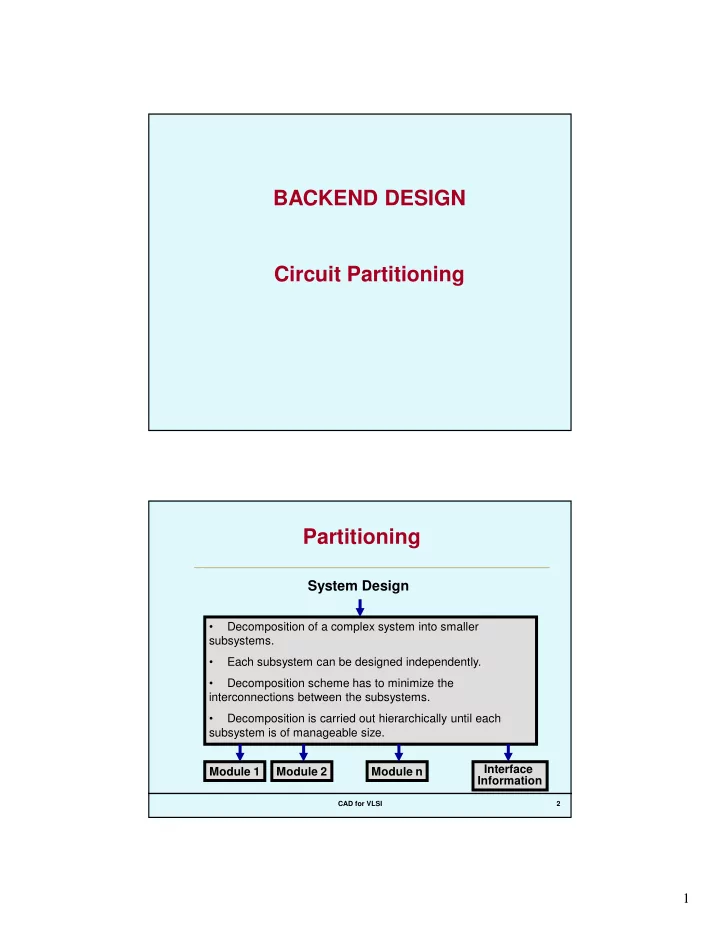

BACKEND DESIGN Circuit Partitioning Partitioning System Design • Decomposition of a complex system into smaller subsystems. • Each subsystem can be designed independently. • Decomposition scheme has to minimize the interconnections between the subsystems. • Decomposition is carried out hierarchically until each subsystem is of manageable size. Interface Module 1 Module 2 Module n Information CAD for VLSI 2 1
Cut 1 = 4 Cut 2 = 4 Size 1 = 15 Size 2 = 16 Size 3 = 17 Cut 1 Cut 2 CAD for VLSI 3 Partitioning at Different Levels • Can be done at multiple levels: – System level – Board level – Chip level • Delay implications are different: – Intrachip � � � X � – Intraboard � � 10X � � – Interboard � � 20X � � CAD for VLSI 4 2
Different Delays in a Chip B A X A 10X C C B 10X 20X CAD for VLSI 5 Problem Formulation Partition a given netlist into smaller netlists such • that: 1. Interconnection between partitions is minimized. 2. Delay due to partitioning is minimized. 3. Number of terminals is less than a predetermined maximum value. 4. The area of each partition remains within specified bounds. 5. The number of partitions also remains within specified bounds. CAD for VLSI 6 3
Classification of Partitioning Algorithms Partitioning Algorithms Group Migration Simulation Based Performance Driven Kernighan-Lin Simulated Annealing Fiduccia-Mattheyses Simulated Evolution Goldberg-Burstein CAD for VLSI 7 Group Migration Algorithms • Kernighan-Lin – An iterative improvement algorithm for balanced two-way partitioning. • Goldberg-Burstein – Uses properties of graphs to improve the performance of K- L algorithm. • Fiduccia-Mattheyses – Considers multi-pin nets. – Can generate partitions of unequal sizes. – Uses efficient data structure to represent nodes. CAD for VLSI 8 4
Extension of K-L Algorithm • Unequal sized blocks – To partition a graph with 2n vertices into two subgraphs of unequal sizes n1 and n2: • Divide the nodes into two subsets A and B, containing MIN(n1,n2) and MAX(n1,n2) vertices respectively. • Apply K-L algorithm, but restrict the maximum number of vertices that can be interchanged in one pass to MIN(n1,n2). CAD for VLSI 9 • Unequal sized elements – To generate a two-way partition of a graph whose vertices have unequal sizes: • Assume that the smallest element has unit size. • Replace each element of size s with s vertices which are fully connected (s-clique) with edges of infinite weight. • Apply K-L algorithm to the modified graph. CAD for VLSI 10 5
Simulated Annealing and Evolution • These belong to the probabilistic and iterative class of algorithms. • Simulated Annealing – Simulates the annealing process used for metals. – As in the actual annealing process, the value of temperature is decreased slowly till it approaches the freezing point. • Simulated Evolution – Simulates the biological process of evolution. – Each solution (generation) is improved in each iteration by using operators which simulate the biological events in the evolution process. CAD for VLSI 11 Simulated Annealing • Concept analogous to the annealing process for metals and glass. • A random initial partition is available as input. • A new partition is generated by exchanging some elements. • If the quality of partition improves, the move is always accepted. • If not, the move is accepted with a probability which decreases with the increase in a parameter called temperature (T). CAD for VLSI 12 6
The Annealing Curve Local Minima T Global Minima Time CAD for VLSI 13 Simulated Annealing Algorithm Algorithm SA begin t = t 0 ; cur_part = ini_part; cur_score = SCORE (cur_part); repeat repeat comp1 = SELECT (part1); comp2 = SELECT (part2); trial_part = EXCHANGE (comp1,comp2,cur_part); trial_score = SCORE (trial_part); δ δ s = trial_score – cur_score; δ δ CAD for VLSI 14 7
if ( δ δ δ δ s < 0) then cur_score = trial_score; cur_part = MOVE (comp1, comp2); else r = RAND (0,1); if (r < exp(- δ δ δ δ s/t)) then cur_score = trial_score; cur_part = MOVE (comp1, comp2); until (equilibrium at t is reached); t = α α α t; /* 0 < α α α α < 1 */ α until (freezing point is reached); end. CAD for VLSI 15 • The SCORE function Imbalance (A,B) = � � � � size(A) – size(B) � � � � Cutcost (A,B) = Sum of weights of cut edges Cost = W 1 * Imbalance(A,B) + W 2 * Cutcost(A,B) • The MOVE function – Several alternatives : • Pairwise exchange (W 1 =0) • Subsets of elements exchanged • Select that node – which is internally connected to least number of vertices – whose contribution to external cost is highest CAD for VLSI 16 8
Performance Driven Partitioning • Typically, on-board delay is three orders of magnitude larger than on-chip delay. – On-chip delay is of the order of nanoseconds. – On-board delay can be in the order of milliseconds. • If a critical path is cut many times by the partition, the delay in the path may be too large to meet the goals of high-performance systems. • Goal of partitioning in high-performance systems: 1. Reduce the cut-size. 2. Minimize the delay in critical paths. 3. Timing constraints have to be satisfied. CAD for VLSI 17 Contd. • The problem can be modeled as a graph. – Each vertex represents a component (gate). – Each edge represents a connection between two gates. – Each vertex has a weight specifying the component delay. – Each edge has a weight, which depends on the partitions to which the edges belong. • This problem is very general and still a topic of intensive research. CAD for VLSI 18 9
Summary • Broadly, two classes of algorithms: 1. Group migration based • High speed • Poor performance 2. Simulation based • Low speed • High performance CAD for VLSI 19 10
Recommend
More recommend